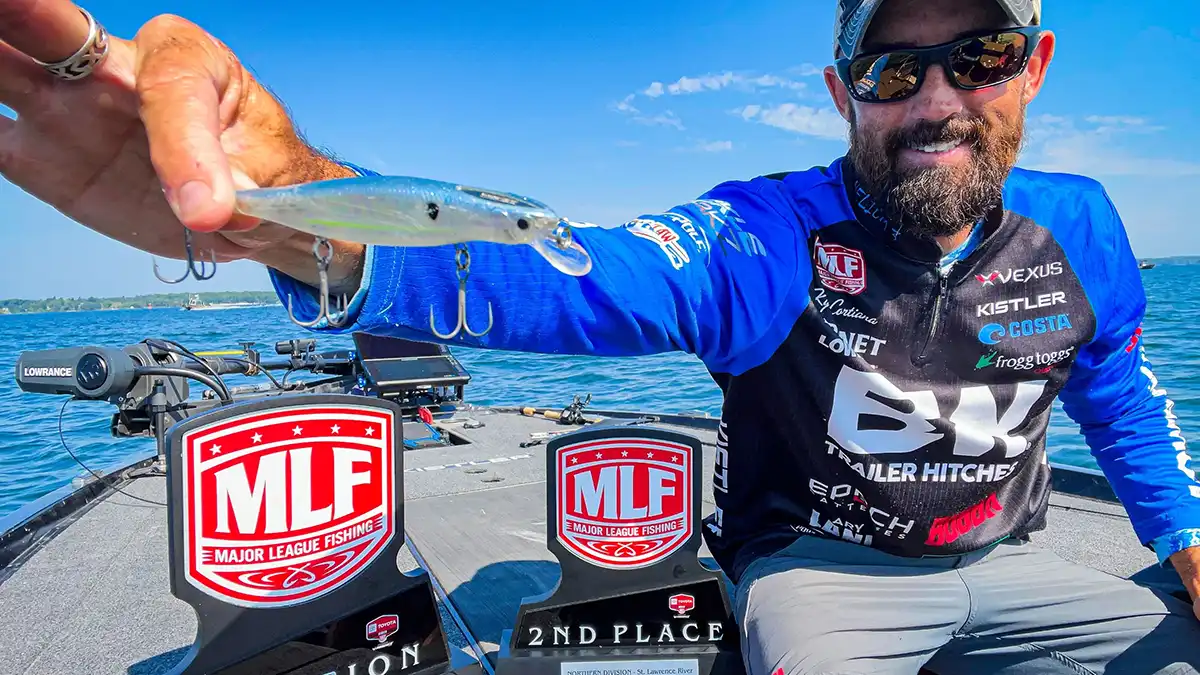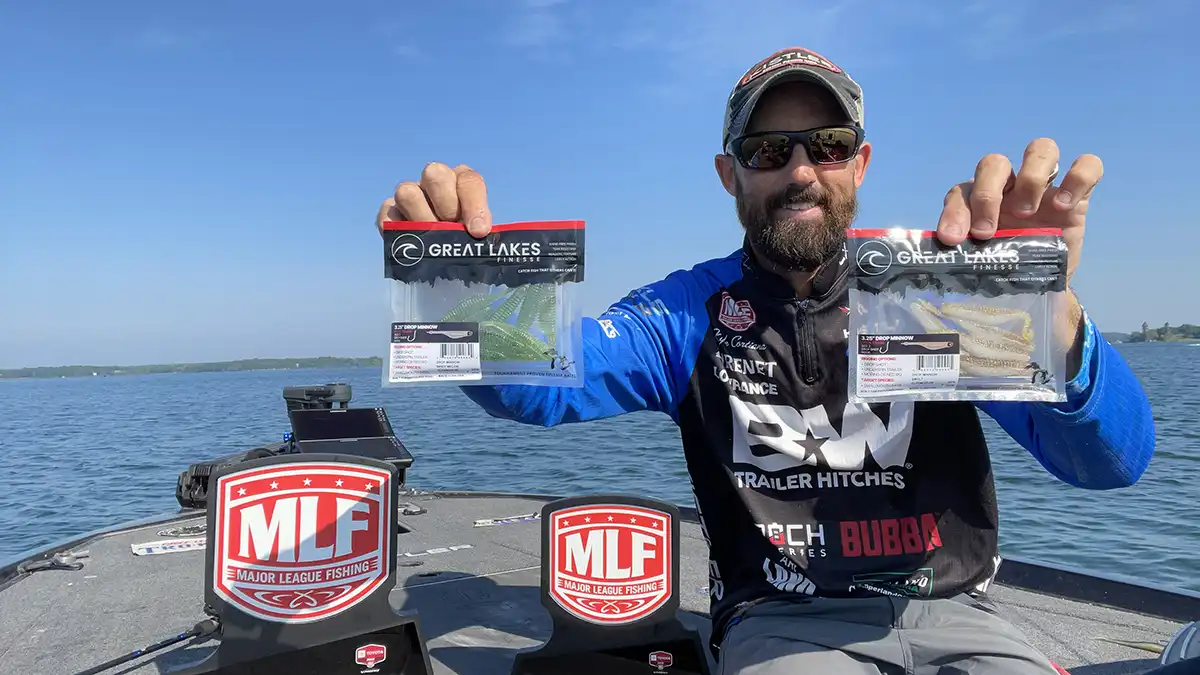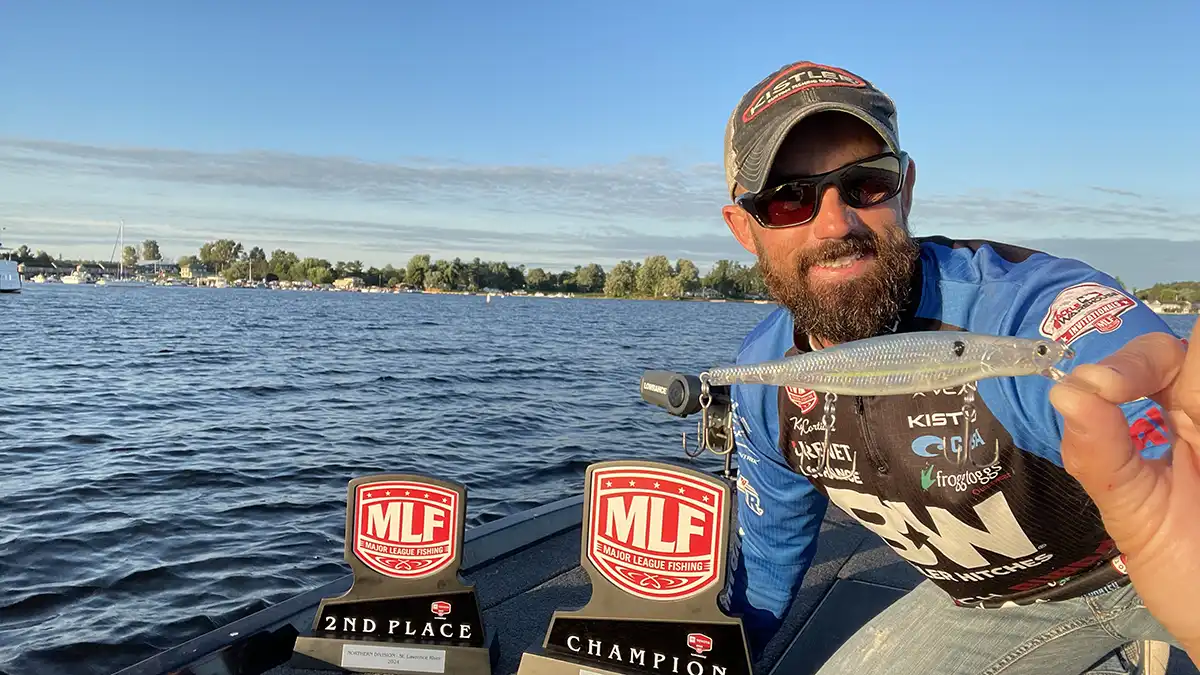1. Who is Kyle Cortiana?
“I was born and raised in Tulsa, Oklahoma. I’ve been there my whole life; went to Oklahoma State University and got my civil engineering degrees. It’s also where I met my wife, Miranda. I did civil engineering for 14 years in Oklahoma and fished the FLW tour the last three or four years of my engineering career. Basically, I was balancing two full-time gigs. In 2021 I got Covid, and I got really, really sick. After this my wife and I decided to sell our home and quit our jobs, buy a camper and an F-350. So my wife quit her job in healthcare, and I quit my engineering job, and we went fishing full time.
Fast forward to now, and I’ve just now won my first big tour-level event on Lake Champlain. I’ve had three second place finishes, and one I actually tied for first place. I had the winning weight exactly tied, but lost by the tiebreaker rule. So I’ve been very close, and it was nice to finally seal one up this year. I’d won a Southwest division AOY in 2016 so now I got one up north. I’ve also been chatting with my good friend Jody white at MLF, he’s a statistics man. He said there’s only been one angler since they’ve started keeping records in 2004 that has acquired an AOY title in two different divisions in 20 years. I found that kind of crazy. I figured that had happened more times than once.”
2. What Baits Helped You Secure Your Northern AOY Title?
“The Booyah Pad Crasher caught some really key fish at Stop #1 on the Potomac River. I also caught some good fish on a wacky rigged Yum Dinger. On stop #2, I integrated a drop shot and a Yum FFS Minnow. Numerous colors played this week, but on the final couple days I dialed into a gold shiner pattern that the fish were coughing up in my boat. I didn’t even know Champlain had these little gold minnows, but when they started coughing up gold minnows, I made a switch to Ayu and Tenkiller Gold. In my mind, mentally, it made a difference.
Then on the St Lawrence River I got my hands on a brand new Booyah Flash Point Jerkbait. On the first day I took the bait out practicing I had 24 pounds on that thing in like two and a half hours. I think I only lost one fish out of like, 12 or 15 hookups. That’s just unheard of on a jerkbait. So immediately I had the confidence in the hooks along with the bait, so that was a really big key for me. On the shallow water fish however, it was all about the Yum Flash Mob Junior combined with new 3.25-inch Great Lakes Finesse Drop Minnow. I found fish staging behind ledges and isolated boulders in little groups. I used the Yum Flash Mob Junior to target those fish so I could actually let the bait just sit there and glide. The Great Lakes Finesse baits are neutrally buoyant, so it can just kind of float in their face until they eat, and that works pretty good.”
3. Does Northern Smallmouth Fishing Relate to Anything You’re Used to in Oklahoma?
“Absolutely not. I mean, when someone says northern smallmouth fishing, I really only think of just a few bodies of water. St Clair, Champlain, the Great Lakes in general, the St Lawrence River, all that. Now the only common denominator between here and Oklahoma is a species of fish called the smallmouth. Back home in Oklahoma, probably our best smallmouth Lake, Lake Tenkiller, has some 5.5, 6 pound smallmouth in it. But they’re a southern smallmouth. They don’t behave the same. They don’t set up the same. But they’re still the coolest fish in Oklahoma.
When I first started traveling up north, I wasn’t real good at fishing up there, but I was super excited every time I went there. I was just consumed with getting dialed in on these northern fish. I love them so much, and it’s such a such a special, fun place to be. I want to figure out how to catch the most and the biggest ones in here so I could fully appreciate it. I’ve just been passionate about it ever since I was a kid. My dad and I used to take our little 15-foot Coleman canoe and float down the Elk River in Noel, Missouri, and we’d drag little craws behind the canoe. We were lucky if we caught a 15-inch smallmouth, but I just loved catching fish. It was so cool to me, but no, it’s nothing like northern smallmouth. It’s all different, but they’re still the same cool fish.”
4. What Set You Apart From Other Anglers in These Events?
“It’s mostly attributed to my lifestyle change and being all-in on fishing. It’s the only way I bring any money in, but it also affords me a lot more time on the water. Along with that, all these fisheries change. I don’t care if you’re talking about a grass fishery and the grass disappears, or you’re talking about these northern fisheries that have obviously had huge changes. So all this extra time I’m getting to spend up here helps. It’s relative, it’s now. It’s not what it used to be, it’s what it is. So I think that negates some of the people that have grown up here, been raised up here, some of the bigger names that are that are living up here, that have already been on TV, some of their spots and techniques have been divulged, and so they’re not as good anymore or secretive as they once were.
So me coming up here not having any preconceived ideas. I’m just getting to fish the fishery and break it down for what it is. I’ve learned to not watch all that stuff and just try to figure out. I had a week at the Potomac to get in tune with the tide and how the fish were setting up. Eventually my brain clicked. I think I know how to run tides, at least this year. Then after the Invitational I was on Champlain the whole time, all the way leading up to the Toyota Event. So I literally had three, maybe four weeks on Champlain. So I had so much time, and I had too much stuff. It almost messed me up. Then I had almost a month on the St. Lawrence River. I knew what I was going to do and where I was going to fish. A week and a half before the Toyota series started, I was already done practicing. I was just running elsewhere, trying to find some crazy 30-pound bag or something.”
5. Do You Have Any Advice for Up and Coming Anglers Looking to Follow Your Path?
“Yeah, this is something I think about a lot, and I get asked a lot as well. I really think there’s two really important things that I would want to communicate to a young up and coming angler. Don’t be entitled. Don’t go to potential partners thinking that they already owe you something. You’ve got to build friendships first if you want to make it in this sport. It’s going to take time, not months. It’s going to take years to build those relationships, so start now. Start every time you get an opportunity to build that friendship with someone that might be a business supporter down the road. Take the time to grow that, year after year after year.
Number two is, your Plan A can’t be fishing. Your Plan A has to be finding what your career path would be if you weren’t fishing. You have to have that fallback sport, because it’s just not a rich sport. It’s not a financial viable option. In fact, it’s one of the worst business decisions an individual could ever make if money is required to live, and sadly it is. The only way you succeed in this business is to win an event at least once a year. I’m talking big events, which is not easy to do. You have to do that once a year, and 90% of anglers will never do that once, let alone once a year.
You’re basically going to have to be cool with living in a camper down by the river and and be good with that. Every now and then, you might have a good year. But like I said, your financial dollars are unknown. Every year, starting November, December, you have zero idea how much money you’re making. You literally start the season with a $0 salary, and you have to re-negotiate, make new phone calls, sign new contracts, and put down deposits to your tournaments. You’ve got to be a gambler, it’s super high risk. Understand there’s a really good chance that within 10 years, you might be hanging it up and going back to your Plan A. You need that safety net or it could be really rough for you for the rest of your life.”
















